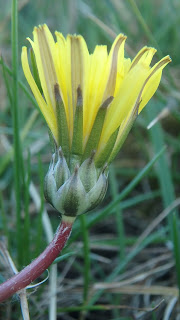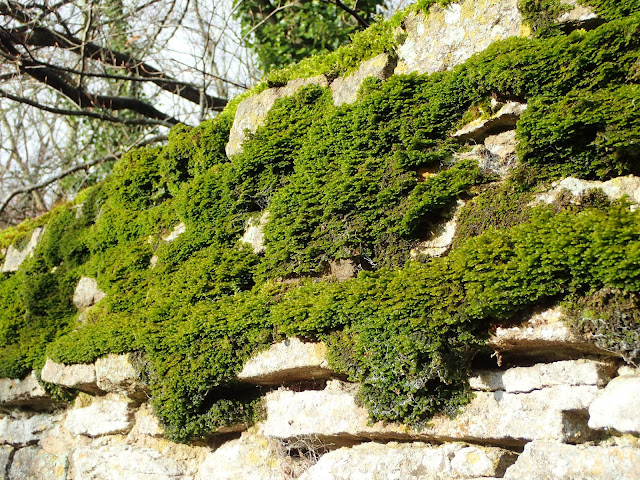Our 4th bryophyte excursion of the 2019/20 season was to the old Chinnor Quarry at
SP7500. Four bryologists were in attendance on what was a pretty grey and damp Sunday (12/01/2020). Despite this, things got off to a good start in the small, recently planted woodland adjacent to the car park at
SP757004. Earlier in the year on a vascular plant survey this woodland had offered up some gems, including the White Helleborine (
Cephalanthera damasonium), and it didn't disappoint now either. David quickly found
Microbryum davallianum on crumbling soil along the central path through the woodland, alongside some infertile
Aloina (most probably
aloides judging by the amount of this species that we later saw in the old quarry).
 |
| Microbryum davallianum |
Crossing over into the old quarry, now surrounded on one side by a housing estate,
Aloina aloides (confirmed microscopically) was quickly picked up in the somewhat surreal damp chalky moonscape that dominates this area.
 |
| Aloina aloides |
|
 |
| The Chinnor moonscape (ok, there was some grass as well...) |
|
After inspecting what seemed like acres of
Didymodon fallax, we picked up a few more unusual species,
Campyliadelphus chrysophyllus for one. This is a species that is well-known to haunt the floors of damp chalk quarries, but it was the first time that any of us had seen it in Oxfordshire.
 |
| Campyliadelphus chrysophyllus at Chinnor |
One species that we did hope to refind was
Leiocolea badensis, a species recorded from the Chinnor quarries once in the 1960s, but never since. We found
Leiocolea turbinata, its commoner congener, quite quickly, but, unfortunately, despite collecting several candidates for checking, we failed to locate the rarer species. Other interesting species in the quarry area included
Campylium protensum,
Cratoneuron filicinum, and
Aneura pinguis, all in the vicinity of the large pond pictured below, and all species of damp calcareous habitats.
 |
| The pond area at SP759002 |
After lunch, we inspected an interesting area of sandy ground forming the football pitch of the housing estate previously mentioned. This was made of soil that had presumably been brought in for the purpose, and had abundant
Phascum cuspidatum and occasional
Pohlia annotina, the latter a species that has only four other records for Oxfordshire, and was last recorded for the vice-county in 1991. The rest of the excursion was filled by recording the wooded slope rising up to the Ridgeway footpath, and then circling back to the original car park. More
Microbryum was encountered in patchy roadside grassland alongside the roundabout at SP758004, as was some
Brachythecium mildeanum, our first record of this species for the season. The full list follows (duplicates are those recorded in the car park wood as well as the main square):
| Mosses |
|
|
Liverworts |
| Aloina aloides s.str. |
Ctenidium molluscum |
Orthotrichum affine |
Aneura pinguis |
| Amblystegium serpens |
Dicranella varia |
Orthotrichum affine |
Cololejeunea minutissima |
| Barbula convoluta var. convoluta |
Dicranoweisia cirrata |
Orthotrichum diaphanum |
Leiocolea turbinata |
| Barbula unguiculata |
Didymodon fallax |
Orthotrichum diaphanum |
Metzgeria furcata |
| Brachythecium mildeanum |
Didymodon fallax |
Oxyrrhynchium hians |
Radula complanata |
| Brachythecium rutabulum |
Didymodon insulanus |
Oxyrrhynchium hians |
|
| Brachythecium rutabulum |
Fissidens incurvus |
Phascum cuspidatum |
|
| Bryoerythrophyllum recurvirostrum |
Fissidens taxifolius |
Plagiomnium undulatum |
|
| Bryum argenteum |
Fissidens taxifolius |
Plagiomnium undulatum |
|
| Bryum capillare |
Funaria hygrometrica |
Pohlia annotina |
|
| Bryum capillare |
Funaria hygrometrica |
Pseudocrossidium hornschuchianum |
|
| Bryum dichotomum |
Grimmia pulvinata |
Pseudoscleropodium purum |
|
| Bryum dichotomum |
Grimmia pulvinata |
Rhynchostegium confertum |
|
| Bryum pseudotriquetrum |
Homalothecium lutescens |
Rhytidiadelphus squarrosus |
|
| Bryum rubens |
Homalothecium lutescens |
Schistidium crassipilum |
|
| Calliergonella cuspidata |
Homalothecium sericeum |
Syntrichia laevipila |
|
| Calliergonella cuspidata |
Hypnum cupressiforme var. cupressiforme |
Syntrichia montana |
|
| Campyliadelphus chrysophyllus |
Hypnum cupressiforme var. resupinatum |
Syntrichia ruralis var. ruralis |
|
| Campylium protensum |
Kindbergia praelonga |
Thamnobryum alopecurum |
|
| Ceratodon purpureus |
Kindbergia praelonga |
Tortula muralis |
|
| Cirriphyllum piliferum |
Leptodictyum riparium |
Tortula muralis |
|
| Cratoneuron filicinum |
Microbryum davallianum |
Tortula subulata |
|
| Cryphaea heteromalla |
Microbryum davallianum |
Zygodon viridissimus var. viridissimus |
|





































